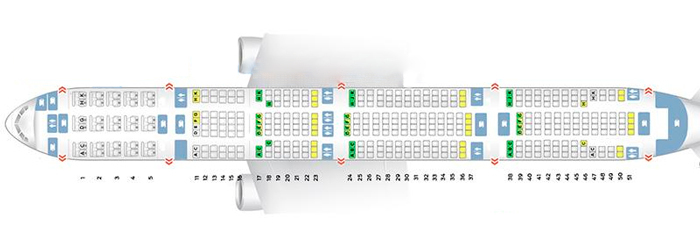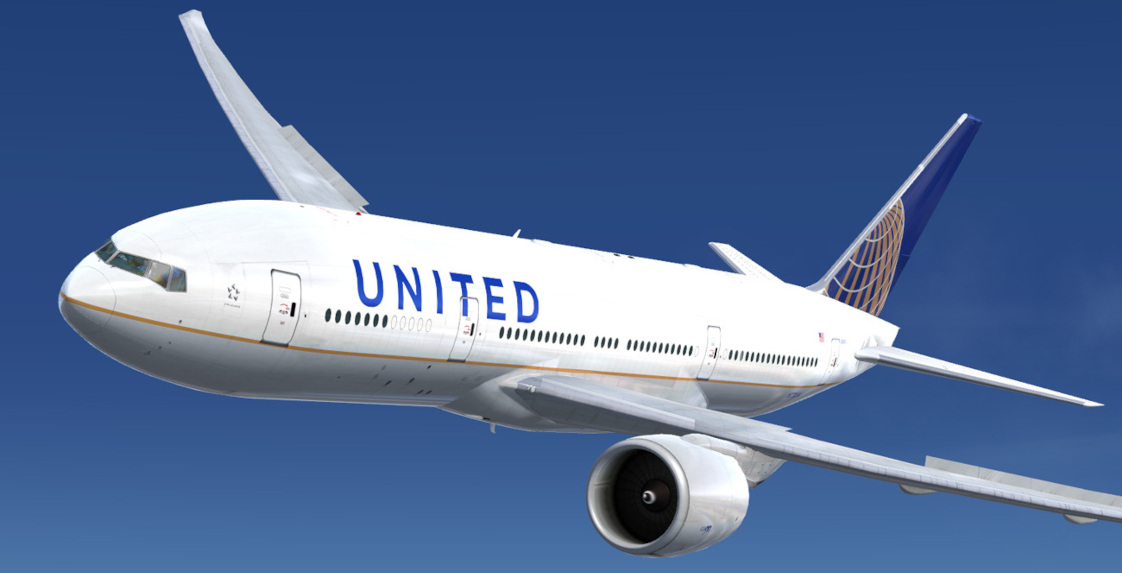
Boeing 777-300ER Overview
The Boeing 777-300ER is a continuation of the lineup started with the 777-200ER model. Equipped with two jet engines with a total output of 175,000 horsepower, this version of the «three-hundred-thirty» is capable of accelerating from 0 to 96 km/h in just 6 seconds. It is because of these impressive specifications that this engine was entered into the Guinness Book of World Records as the most powerful jet engine in the world. This outstanding power not only provides impressive acceleration speeds, but also enables the Boeing 777-300 ER to travel long distances with ease, making it the ideal choice for long-distance intercontinental flights.
The combined perfection of technology and engineering excellence makes the Boeing 777-300ER not just an airliner, but a symbol of modern aviation, where outstanding performance combined with passenger comfort are prioritized in the pursuit of the ideal long-haul aircraft.
The Boeing 777 300ER (ER — which stands for Extended Range) is a long-range passenger airplane that can carry between 301 and 550 passengers (depending on cabin configuration). It has more autonomy than the standard Boeing 777-300 due to its large additional fuel tank. The B777-300ER can fly continuously over longer distances, making it an ideal choice for airlines organizing long lines.
When it comes to safety and reliability, the Boeing 777-300ER leaves no room for doubt. This aircraft has been certified and meets the highest safety standards set by the International Air Transport Association (IATA) and the U.S. Federal Aviation Administration (FAA).
The construction and materials used in the Boeing 777 300ER provide superior strength and resistance to various factors such as overloads, turbulence and atmospheric conditions. All aircraft systems, including electrical, hydraulic and pneumatic systems, are rigorously tested prior to each flight to ensure they operate reliably.
Development of the Boeing 777-300ER
In the dynamic field of aviation, few achievements can match the significance of the Boeing 777-300ER airplane. When the aviation industry faced increasing demands for greater range, efficiency and passenger capacity, Boeing embarked on the 777-300ER project.
The story of the Boeing 777 300ER began in the late 1980s when Boeing set out to develop a new long-range passenger airplane that would offer improved efficiency, comfort and range over previous models.
The 777-300ER made its first flight on February 24, 2003. Official certification was received in April 2004. This airplane has become popular with airlines seeking high performance and passenger comfort.
The Boeing 777-300ER airplane is designed using state-of-the-art technology and engineering excellence to meet the high demands of modern aviation. The design of the Boeing 777-300ER involved intensive use of computer simulation and aerodynamic studies to optimize the fuselage and wing shape.
The use of composite materials in the fuselage design reduced the aircraft’s weight, improving its fuel efficiency and maneuverability. State-of-the-art automation and control systems provide the crew with the ability to effectively control all aspects of flight, enhancing the safety and accuracy of aviation operations.
The Boeing 777-300ER is powered by GE90 engines, which are considered one of the most powerful and advanced jet engines in the world. An important feature of this airliner is the use of two of these engines, each designed to provide outstanding thrust and efficiency in a variety of flight modes.
Boeing 777-300ER Technical Details
Passenger cabin
| Crew | 2 pilot |
| Number of passengers | 396 (standard layout), 550 (maximum) |
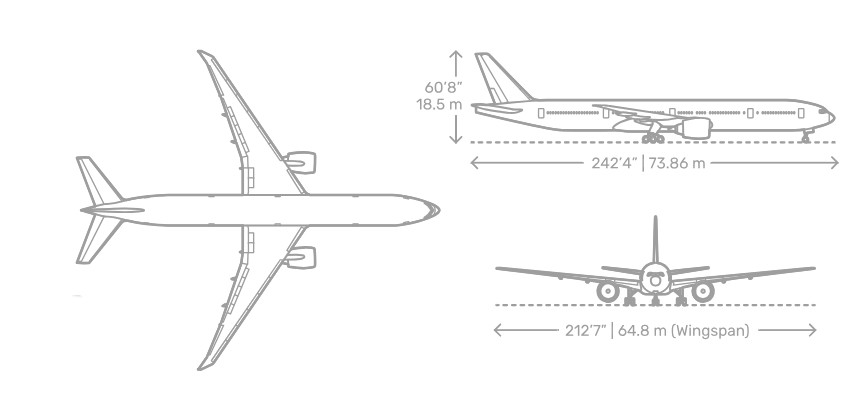
Weight
| Empty kitted weight | 167830 kg |
| Max. takeoff weight | 351530 kg |
| Max. landing weight | 251290 kg |
| Cargo volume | 201,6 cubic meters |
Flight data
| Flight range | 13650 km |
| Cruising speed | 892 km/h |
| Maximum speed | 945 km/h |
| Run-up length | 3050 m |
| Engines | 2 × General Electric GE90 |
| Engine pull (kN) | 2 × 440-513 |
| Maximum fuel quantity | 181280 L |
| Maximum flight altitude | 13100 m |
Dimensions
| Length | 73,90 m |
| Height | 18,50 m |
| Wingspan | 64,80 m |
| Wing area | 436,80 sq. m |
| Fuselage width | 6,20 m |
| Interior width | 5,84 m |
777 300ER Operators
Various global airlines have chosen the Boeing 777-300ER to enhance their long-haul services. Among these operators are industry giants such as Emirates, known for its extensive network of international flights. Singapore Airlines, Qatar Airways, and Air Canada also feature the 777-300ER in their fleets, offering passengers a combination of comfort and range for their journeys. Cathay Pacific, Etihad Airways, and Turkish Airlines utilize the aircraft on diverse routes, connecting travelers across continents. Other notable operators include ANA (All Nippon Airways), British Airways, and Air France, each integrating the 777-300ER to cater to their passengers’ needs during extended flights. As the aviation landscape evolves, the Boeing 777-300ER remains a preferred choice for leading airlines, ensuring a seamless and enjoyable travel experience for passengers worldwide.
Boeing 777-300ER Seat Map
In a single-class cabin configuration, the airplane can accommodate 550 passengers. In a two-class configuration, economy + business, the cabin can seat 479 passengers. In the three-class configuration, the airliner is equipped with 368 passenger seats.
Boeing 777-300 ER seats offer a spacious and comfortable travel experience, accompanied by a wide cabin. The cabins of this aircraft are more often organized into two classes: business class and economy class, but there is also a first class.
First Class
The First Class cabin consists of full-fledged separate compartments in the 1st and 2nd rows (2+2+2). Small rooms are divided between each other by ceiling-high partitions, lighting and temperature inside such a single cabin each traveler can adjust to his taste. In addition to comfortable accommodations, you will have a separate entrance, a multimedia system, satellite phone, power outlets and USB ports, individual menu with vintage wines, virtual porthole — passengers who sit far from the window can look at the scenery in HD format or through binoculars.
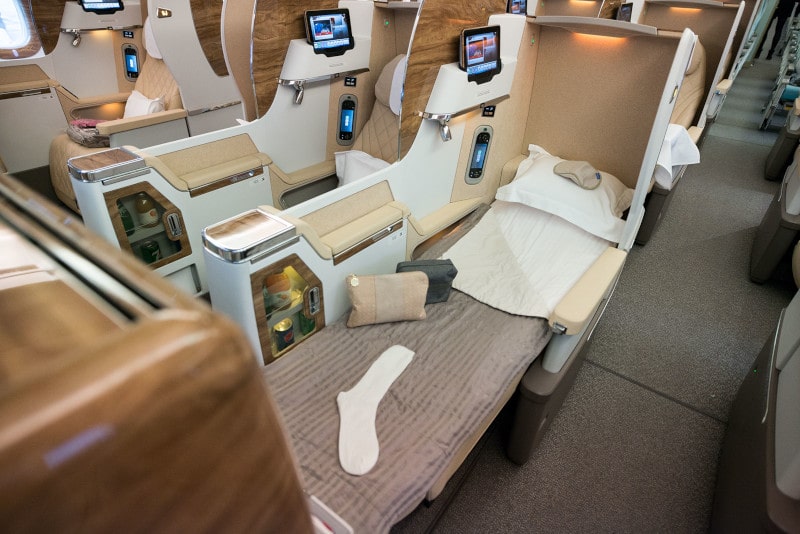
Boeing 777-300ER Business Class
In business class there are armchairs of increased comfort, which are transformed into a two-meter bed. Passengers are offered an individual menu in beautiful dishes, a pumped multimedia system, a separate toilet. In the most modern versions of the Boeing 777-300ER cabin, entire cabins are equipped (28 in total, 4 in a row). They are not isolated from the common space, but create an impression of privacy.
All cabins are identical in terms of comfort and interior space. Only passengers in the side rows, located along the sides of the airplane, have access to the portholes. The others will not see the windows because of the partitions between the seats. In new modifications of Boeing 777-300ER Business Class restrooms are located far from the cabin and do not cause discomfort in the form of extraneous noises to passengers.
Boeing 777-300ER Premium Economy
According to the Boeing 777-300ER seat map, there are 84 seats in the Premium Economy cabin. The seats are arranged according to the Boeing 777 300ER seat map 2-4-2. There are monolithic armrests between the seats, in which retractable tables are hidden. Boeing 777-300ER seating backrests are not reclining, but there are lifting footrests. It is very convenient for long-distance flights. Comfort class passengers can watch movies or listen to music during the flight. Each seat is equipped with a lamp, convenient for reading. There are 6 rows (11-16) in the comfort sector. In the first row of comfort class all seats are equipped with fasteners for baby cradles.
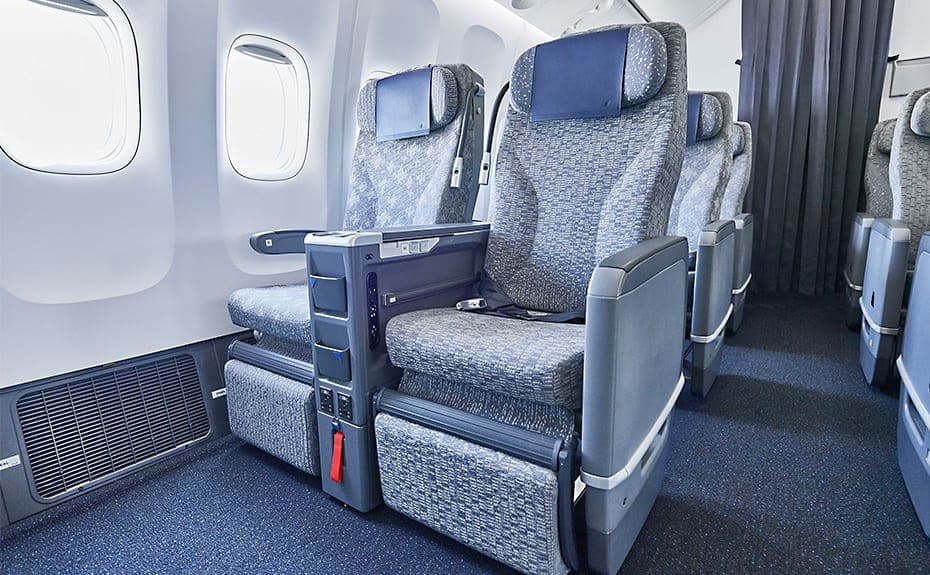
Economy class
Economy class saloons are 586 cm wide, each row has 10 seats (3-4-3), two aisles. The Boeing 777-300ER seating pitch is approximately 80 cm. Due to the fact that metal structures of seats are narrow and do not occupy much space, each passenger has a personal space. Otherwise, everything is familiar: adjustable headrest, multimedia system with touch screen, folding tables and pockets for magazines. Economy class begins from the 17th row — Boeing 777-300ER seats are situated next to the cradle mounts. Another major advantage of the 17th row is that there is plenty of legroom up front and good reclining backrests.
38 row of seats Boeing 777-300ER best seats airplane the emergency exits in front of them imply an increase of free space in front.
Comparison of Boeing 777 300ER Seat Maps
| Airline | Cabin / Configuration | Seats |
|---|---|---|
| British Airways Boeing 777-300ER | First Class / 1-2-1 Club World / 1-2-1 World Traveller Plus / 2-4-2 World Traveller/ 3-4-3 |
299 |
| China Airlines Boeing 777-300ER | Business Class / 1-2-1 Economy Premium / 2-4-2 Economy / 3-4-3 |
358 |
| Aeroflot Boeing 777-300ER | Business Class / 2-2-2 Economy Premium / 2-4-2 Economy / 3-4-3 |
402 |
| Air China Boeing 777-300ER | First Class / 1-2-1 Business Class / 2-2-2 Economy / 3-3-3 |
311 |
| American Airlines Boeing 777-300ER | First Class / 1-2-1 Business Class / 1-2-1 Economy Premium / 2-4-2 Economy Extra / 3-4-3 Economy / 3-3-3 |
304 |
| China Eastern Airlines Boeing 777-300ER | First Class / 1-2-1 Business Class / 1-2-1 Economy / 3-4-3 |
316 |
| Ethiopian Airlines Boeing 777-300ER | Business Class / 2-3-2 Economy / 3-3-3 |
393 |
| Singapore Airlines Boeing 777-300ER | First Class / 1-2-1 Business Class / 1-2-1 Economy Premium / 2-4-2 Economy / 3-3-3 |
264 |
| Swiss Boeing 777-300ER | First Class / 1-2-1 Business Class / 1-2-1 Economy / 3-4-3 |
340 |
| Japan Airlines Boeing 777-300ER | First Class / 1-2-1 Business Class / 2-3-2 Economy Premium / 2-4-2 Economy / 3-3-3 |
244 |
| Thai Airways Boeing 777-300ER | Business Class / 1-2-1 Economy / 3-3-3 |
348 |
| Turkish Airlines Boeing 777-300ER | Business Class / 2-3-2 Economy / 3-3-3 |
349 |
| United Boeing 777-300ER | Business Class / 1-2-1 Economy Premium / 2-4-2 Economy Extra / 3-4-3 Economy / 3-4-3 |
350 |
| Virgin Australia Boeing 777-300ER | Business Class / 1-2-1 Economy Premium / 3-3-3 Economy / 3-3-3 |
339 |
| KLM Boeing 777-300ER | Business Class / 2-2-2 Economy Extra / 3-4-3 Economy / 3-4-3 |
408 |
| Philippine Airlines Boeing 777-300ER | Business Class / 2-3-2 Economy / 3-4-3 |
370 |
| United Boeing 777-300ER | Business Class / 1-2-1 Economy Premium / 2-4-2 Economy Extra / 3-4-3 Economy / 3-4-3 |
350 |
| Emirates Boeing 777-300ER | Business Class / 2-3-2 Economy Premium / 3-4-3 |
427 |
| EVA Air Boeing 777-300ER | Business Class / 1-2-1 Economy Premium / 2-4-2 Economy / 3-4-3 |
353 |
| LATAM Boeing 777-300ER | Business Class / 1-2-1 Economy / 3-4-3 |
379 |
| Etihad Airways Boeing 777-300ER | Business Class / 1-2-1 Economy / 3-4-3 |
370 |
| Air France Boeing 777-300ER | Business Class / 1-2-1 Economy Premium / 2-4-2 Economy / 3-4-3 |
472 |
| Garuda Indonesia Boeing 777-300ER | Business Class / 1-2-1 Economy / 3-4-3 |
393 |
| Qatar Airways Boeing 777-300ER | Business Class / 2-2-2 Economy / 3-4-3 |
412 |

